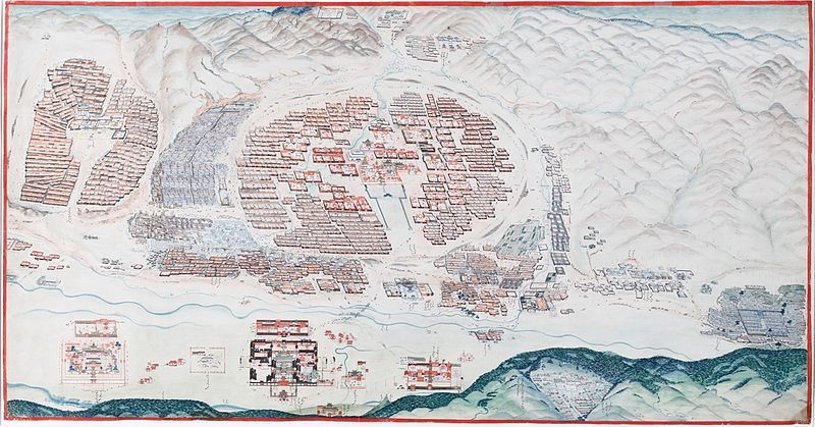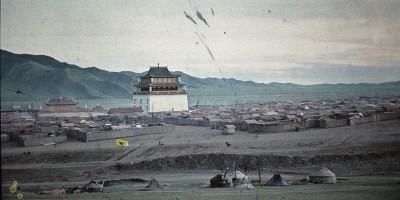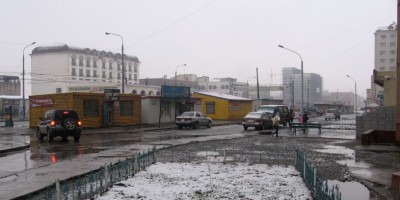This morning I was reading an article which contained the following statement, “The Soviets engineered Ulaanbaatar for a population of 400,000. Now the city holds three times that number.”1 I have seen variants of this statement in other articles over the last few months, and there is something about it that seems dubious. It has the feel of something that was first expressed informally as way of conceptualizing the extraordinary population growth and poor city management in Ulaanbaatar over the last few years, and then morphed into a “fact” in its subsequent retelling.
Employing an apocryphal story of my own, I imagine there once was a group of professionals at Millie’s Cafe discussing the deteriorating infrastructure and over-population of the city and someone chimed in with, “Just think, when the city was originally built it would have been for a population of 400,000 or so.” To which everyone at the table nodded their heads knowingly, because that made perfect sense as an explanation for the world they perceived just outside the cafe’s doors. Not too long after that one of the professionals at the table relayed this “fact” to a journalist doing a story on Mongolia. Yet, does comparing the city today with some alleged Soviet plan in the past make sense? I don’t think so, and here’s why.
According to the Capital Statistics Office, the population of Ulaanbaatar reached 400,000 in 1979.2 By 1990 the city had a population over 560,000. Then about 1998 the annual rate of population growth in the city significantly increased, rapidly pushing the population to 1.2 million by 2012 (see Graph 1). So, if the Soviets engineered the city for 400,000 people, when did this happen? In 1960? Maybe. That would mean that they were over engineering given that the population was 145,000 that year. In 1980? Maybe. But, that would mean that they were building a city already at its population capacity. Is this evidence that Ulaanbaatar was “built” by 1980 even though the population grew another 40 percent over that decade? Or, maybe I have completely misunderstood. Is it that the heating and power infrastructure constructed during the Socialist period was designed with a theoretical capacity of 400,000 people connected to the grid, and the apartment building boom of the last few years has taken the infrastructure well beyond this theoretical limit? But, isn’t that something different than saying the city itself was designed for 400,000 people, especially given its long history of supporting outlying ger districts off the grid? A lot of questions with few good answers.

It is said that Rome was not built in a day. The meaning, of course, being that something as large as a city develops slowly. It is not the product of a single decision or plan executed over a finite period but rather the product of dynamic interactions unfolding continuously over time. I understand the sentiment behind the Soviet-engineering statement. Ulaanbaatar’s infrastructure development has not kept pace with its population growth over the last fifteen years, and the city today is a treasure trove of examples of urban planning and civil engineering gone horribly wrong. But, the statement just doesn’t withstand even lightweight critical analysis even if one accepts the premise that somewhere in an archive there is a city plan for Ulaanbaatar with a population of 400,000 in mind. Ulaanbaatar today is the product of complex actions and reactions played out over several decades–not a single plan made by Soviet engineers. The point the statement is trying to make, I surmise, is that the city seems to have stopped being planned in the not too distant past and subsequently turned into the chaotic urban landscape visible today. That is fair enough, but is it necessary to express that sentiment with allusions to Soviet planning? After all, Ulaanbaatar does have a city planning office (see here), and it has had a democratically elected mayor and city council for more than two decades.
There is no argument that Ulaanbaatar has changed dramatically over the last few years, in some ways for the better and in others for the worse. Wind the clock back twenty or thirty years, and many parts of it are physically unrecognizable. It is true that the city’s layout and much of its heating and power infrastructure were first established during the Socialist period, but much of the city’s skyline and surrounding ger districts have sprung up in just the last fifteen years. Plans drawn up decades ago in the heady days of the Socialist era may have lingering impacts on the city today, but they are only part of a very complex story.
This is exemplified by the city’s roads where past design has arguably hampered contemporary function. Yet, is the problem a decades old Soviet design that failed to scale, or the unregulated construction of buildings in the city’s previously abundant open spaces without regard for critical secondary infrastructure such as roads, power, heating, and sewage? As Prime Minister Batbold pointed out in parliament in 2011, although Ulaanbaatar’s building and housing capacity had grown 3.5 times since 1980, the major road system had basically remained unchanged to that point.3 Graph 2 shows the number of passenger vehicles (cars, trucks, buses; etc) in Mongolia from 1991 to 2007. The number grew by almost four times over that seventeen year period to over 160,000 vehicles. Compare this with 1980 when there were approximately 32,200 vehicles in the entire country, and the majority of those were cargo trucks.4 In Ulaanbaatar there were 108,000 vehicles by 2008, and this nearly doubled to 210,000 vehicles in the city by August 2012.5 Ulaanbaatar’s population has increased significantly since 1980, but this is nothing in comparison to the increase in vehicles on the city’s roads in just the last few years.

Whether or not one accepts that Ulaanbaatar was designed at one point for 400,000 people, today it is most definitely not a city of Soviet design. It retains some elements of its Socialist past, but for better or worse it is the capital of democratic, free-market Mongolia. The lack of regulation in producing secondary infrastructure to support the growth in buildings around the city is a better explanation of the city’s current and inadequate layout than irrelevant allusion to Soviet engineering. The problem isn’t that the city was designed for another population, in another economy, in another time. The problem is that the city’s development over the last two decades has not adequately adapted to its present population, in the current economy, now. Of course, I think that is what is meant by the Soviet-engineering statement, but it goes about it all wrong by making it seem as if the central planning of the Socialist period is more relevant than the lack of regulation in the democratic, free-market era in understanding Ulaanbaatar’s complex urban environment today.
Footnotes
1. Brett Forrest, “James Passin, the American Who Bought Mongolia”, Business Week, http://www.businessweek.com/articles/2013-05-16/james-passin-the-american-who-bought-mongolia, 2013-05-16.
2. See http://www.ubstat.mn/StatTable=11.
3. “Монгол Улсын Ерөнхий сайд С.Батболдын Улаанбаатар хотын авто замын сүлжээнд 2008-2011 онд хийж гүйцэтгэсэн ажил, цаашид авах арга хэмжээний талаар УИХ-ын чуулганы хуралдаанд хийсэн мэдээлэл”, Mongolian Embassy in the United Kingdom, http://www.embassyofmongolia.co.uk/index.php?option=com_content&view=article&id=144%3A-2008-2011-&catid=1%3Alatest-news&Itemid=50&lang=en, 2011-11-19.
4. “1929-2008 ОНУУДАД МОНГОЛ УЛСЫН ХЭМЖЭЭНД ТООЛОГДСОН АВТОМАШИНЫ ТООН ҮЗҮҮЛЭЛТ”, Mongolian Traffic Research Institute, http://www.traffic-institute.mn/h_research/h-01/h-01-01-01.html, (accessed 2013-05-15).
5. “Автомашины тоо эрс нэмэгдсэн нь замын насжилтад нөлөөлж байна гэв”, Gogo.mn, http://news.gogo.mn/r/109525, 2012-08-15.



